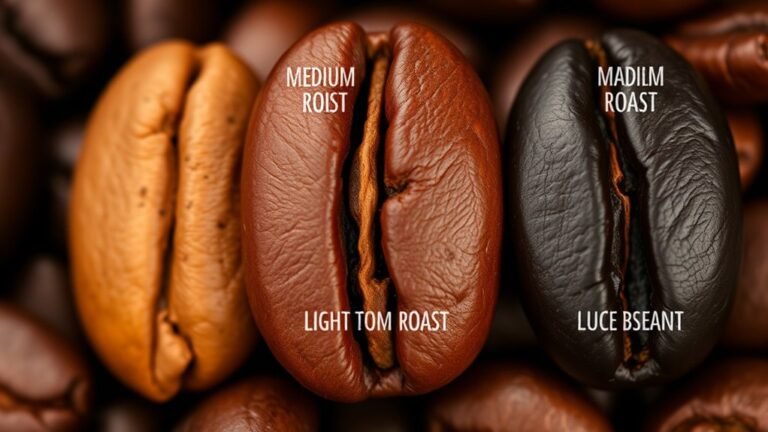Understanding the Different Flavor Profiles of Coffee
You’ll discover that coffee’s flavor profiles result from a blend of factors like origin, soil, and altitude influencing bean characteristics, while traditional processing and roast levels shape complexity and intensity. Acidity adds brightness, sweetness softens, and bitterness deepens the experience, all varying with brewing method and grind. From fruity and floral notes to nutty, chocolatey, or earthy tones, each cup tells a unique story. Explore further, and you’ll reveal even greater nuances behind every flavor.
Factors Influencing Coffee Flavor Profiles

Although many factors shape the flavor profiles of coffee, understanding the key influences can help you appreciate why your cup tastes the way it does. The terroir impact—encompassing soil composition, altitude, climate, and microclimate—plays a pivotal role in defining the nuanced characteristics you detect. These environmental elements interact with the coffee plant, imprinting distinct notes that range from fruity brightness to earthy depth. Additionally, varietal differences among coffee plants introduce unique flavor potentials. Each varietal carries inherent genetic traits that influence acidity, body, and aromatic complexity. By recognizing how terroir combines with varietal nuances, you reveal the freedom to explore coffees beyond generic labels, savoring each cup’s signature identity shaped by nature and heritage. This understanding elevates your tasting experience to an informed, expressive journey.
The Role of Coffee Bean Origin
You’ll notice how the unique climate, soil composition, and elevation of a coffee-growing region shape the beans’ flavor nuances. Traditional processing methods passed down through generations also leave a distinct imprint on the cup’s profile. Understanding these factors helps you appreciate why origin matters so much in your coffee experience.
Regional Climate Impact
When you explore how regional climates shape coffee’s flavor, you’ll find that each origin tells a unique story through its beans. Climate variations—from temperature swings to rainfall patterns—directly influence the development of sugars and acids within the coffee cherry. In cooler, stable climates, you might notice brighter acidity and more pronounced floral or citrus notes, while warmer, more humid regions often yield fuller-bodied beans with earthy or spicy undertones. This interplay of climate with the regional terroir—the complete natural environment—crafts distinct flavor signatures that you can trace back to place. Understanding these subtle nuances allows you to appreciate the freedom each cup offers, revealing how nature’s variability becomes an essential ingredient in the complex art of coffee tasting.
Soil and Elevation
Since coffee’s flavor is deeply influenced by its origin, understanding how soil composition and elevation shape bean characteristics is essential. Different soil types—volcanic, sandy, or clay-rich—imbue beans with distinct mineral profiles, subtly altering acidity, body, and sweetness. When you explore coffee from volcanic soils, expect vibrant, complex notes due to rich nutrients. Elevation impact also plays a significant role. Higher altitudes slow bean maturation, intensifying flavors and enhancing acidity, while lower elevations yield milder, more straightforward profiles. By grasping these elements, you gain freedom to select coffees that resonate with your palate, appreciating how earth and altitude craft each cup’s unique essence. This nuanced understanding elevates your coffee experience beyond mere taste, connecting you to the land where each bean was born.
Traditional Processing Methods
Although the origin of coffee beans profoundly influences their flavor, the traditional processing methods used in different regions play an equally essential role in shaping the final cup. You’ll find that these methods—natural, washed, and honey processing—each bring unique fermentation effects and drying techniques that deeply affect taste and aroma. Consider these regional variations:
- Natural processing emphasizes sun-drying whole cherries, imparting fruity, wine-like notes but demands careful environmental impact management.
- Washed processing removes the cherry before drying, highlighting clarity and brightness in flavor.
- Honey processing balances fruitiness and acidity by partially removing the cherry’s mucilage.
- Drying techniques, influenced by local climate, further refine complexity.
Understanding these methods lets you appreciate how tradition and environment liberate coffee’s diverse flavor spectrum.
Impact of Roast Levels on Taste
Because roast levels profoundly shape the flavor characteristics of coffee, understanding their impact is essential for appreciating your brew. As you explore light, medium, and dark roasts, you’ll notice how the roasting process influences flavor development and roast color. Light roasts preserve more of the bean’s original acidity and nuanced flavors, offering a delicate roast aroma with a brighter taste perception. Medium roasts strike a balance, enhancing sweetness and body while maintaining moderate flavor intensity. Dark roasts, with their deeper roast color, emphasize boldness and smoky notes, often masking subtle origin traits but increasing roast aroma richness. Notably, caffeine content slightly decreases as roast levels darken, though flavor intensity rises. Knowing how each roast level transforms taste empowers you to select coffee that truly aligns with your personal freedom to savor.
Common Flavor Notes in Coffee

When you taste coffee, you’ll often notice bright fruity and citrus notes that add a lively zing to the cup. These contrast beautifully with deeper nutty and chocolate flavors that bring warmth and richness. Subtle floral and herbal aromas further layer the experience, making each sip uniquely complex.
Fruity and Citrus Notes
Even if you’re new to tasting coffee, you’ll notice how fruity and citrus notes can brighten a cup, adding layers of complexity that engage your palate. These flavors often evoke the freshness of tropical fruits and the sweet tartness of berry flavors, creating an invigorating experience. When you explore coffees with these profiles, consider:
- The zesty acidity reminiscent of lemons or oranges, which enlivens each sip.
- Subtle hints of tropical fruits like mango or pineapple, lending a juicy sweetness.
- Berry flavors—think blueberries or raspberries—that bring a vibrant, tangy depth.
- How these notes balance with the coffee’s body, enhancing its overall clarity and brightness.
Embracing these nuances lets you savor coffee as a dynamic, expressive beverage, freeing you to enjoy every distinct cup fully.
Nutty and Chocolate Flavors
As you explore deeper into coffee tasting, you’ll find that nutty and chocolate flavors offer a comforting richness that complements brighter notes beautifully. When you detect nutty aromas, think of roasted almonds or hazelnuts—these scents add warmth and depth, grounding the coffee’s profile. Chocolate textures range from creamy milk chocolate to intense dark cocoa, providing a velvety smoothness that balances acidity. These flavors often emerge from medium to dark roasts, where sugars caramelize and deepen complexity. When you savor these notes, you reveal a sensory freedom, appreciating coffee’s ability to evoke both indulgence and familiarity. Embracing nutty and chocolate flavors expands your tasting experience, allowing you to enjoy coffee not just as a beverage, but as a nuanced journey of flavor and aroma.
Floral and Herbal Aromas
Beyond the comforting warmth of nutty and chocolate flavors, coffee reveals a delicate spectrum of floral and herbal aromas that invite a different kind of appreciation. When you explore these notes, you uncover layers that elevate your experience beyond mere caffeine.
- Jasmine notes often emerge subtly, lending a fragrant sweetness that feels both fresh and invigorating.
- Herbal blends introduce complexity, evoking scents reminiscent of thyme, sage, or rosemary, grounding the coffee in nature’s garden.
- These aromas can brighten the cup, balancing richer flavors with airy, almost ethereal qualities.
- Understanding these nuances empowers you to select beans that resonate with your palate’s freedom, allowing you to savor coffee as a dynamic, living art.
Embracing floral and herbal profiles expands your journey, revealing coffee’s boundless character beyond tradition.
Understanding Acidity in Coffee

While acidity in coffee often gets mistaken for sourness, it actually refers to a vibrant brightness that enlivens the cup and highlights its complex flavors. You’ll notice coffee acidity as a crisp, lively sensation that dances on your palate, bringing clarity and lift. It’s essential to the flavor balance, preventing the brew from feeling flat or dull. Different origins and roast levels influence the type of acidity you experience—whether it’s a sharp citrus zing or a gentle, wine-like tang. Understanding coffee acidity lets you appreciate its role in defining character and freshness, allowing you to explore coffees with greater freedom. Embracing this nuance enhances your ability to select beans that match your taste and elevate your coffee journey.
Sweetness and Bitterness Balance
Acidity gives coffee its lively brightness, but it’s the interplay between sweetness and bitterness that shapes its overall harmony. When you savor a cup, you’re experiencing a delicate sweetness balance that tempers the bitterness contrast, creating a nuanced flavor dance. Here’s what to contemplate:
Acidity brightens coffee, while sweetness and bitterness blend to create a nuanced, harmonious flavor experience.
- Sweetness balance softens harsh edges, often found in caramel or honey notes.
- Bitterness contrast adds depth, preventing the coffee from tasting flat or overly sweet.
- The right roast level influences this balance—lighter roasts highlight sweetness, darker roasts enhance bitterness.
- Personal preference and brewing precision let you explore this spectrum, liberating you to find your ideal harmony.
Mastering this balance reveals a fuller, richer coffee experience that’s both satisfying and complex.
How Brewing Methods Affect Flavor
Since brewing methods extract flavors differently, they play a crucial role in shaping your coffee’s final profile. You’ll find that brewing temperature directly influences which compounds dissolve; hotter water emphasizes bitterness and body, while cooler temps highlight brightness and clarity. Grind size also determines extraction speed—finer grounds speed up flavor release, risking over-extraction and harshness, whereas coarser grounds slow it down, potentially under-extracting and muting complexity. Whether you prefer the immersion of a French press, the precision of a pour-over, or the intensity of an espresso, each method manipulates these variables uniquely. By mastering your brewing temperature and grind size, you gain the freedom to tailor your cup’s balance, highlighting subtle notes or bold richness exactly how you want it.
Identifying Fruity and Floral Coffee Profiles
Understanding how brewing methods influence flavor sets the stage for recognizing specific taste characteristics, like fruity and floral notes, in your coffee. To identify these profiles, you should:
- Smell deeply: Fruity aromas often resemble berries, citrus, or stone fruits, inviting a vibrant sensory experience.
- Taste attentively: Floral notes bring delicate, tea-like qualities—think jasmine or hibiscus—that add complexity.
- Note acidity levels: Higher acidity often enhances fruity brightness; lower acidity may soften floral subtleties.
- Observe aftertaste: Fruity coffees linger with a juicy, sweet finish, while floral profiles leave a clean, perfumed sensation.
Exploring Nutty and Chocolatey Flavors
You’ll notice nutty notes often originate from beans grown in regions with specific soil compositions and roasting levels that highlight their natural richness. Chocolatey flavors tend to present as smooth, bittersweet, and velvety, adding depth without overpowering the cup. Understanding how these profiles complement each other can elevate your tasting experience and guide your pairing choices.
Origins of Nutty Notes
Although nutty and chocolatey notes might seem straightforward, their origins in coffee are deeply complex and tied to specific bean varieties, processing methods, and roasting profiles. When you explore nutty origins, you uncover a spectrum of flavor nuances shaped by:
- Bean Variety: Some cultivars, like Bourbon or Typica, naturally carry nutty undertones.
- Processing Method: Dry processing often enhances these notes by preserving sugars and oils.
- Roasting Profile: Medium roasts tend to amplify nutty characteristics without overpowering them.
- Terroir: Soil composition and altitude subtly influence the development of nutty flavors.
Chocolatey Flavor Characteristics
Nutty notes often pave the way to appreciating the rich, deeper complexity of chocolatey flavors in coffee. When you experience a chocolatey aroma, it’s not just a scent but a gateway to a profound chocolatey sweetness that balances bitterness with smooth richness. These flavors invite you to savor coffee in a way that feels indulgent yet natural.
| Flavor Aspect | Description |
|---|---|
| Chocolatey Aroma | Deep, inviting scent reminiscent of cocoa or dark chocolate |
| Chocolatey Sweetness | Subtle sugar-like notes that soften bitterness |
| Texture Influence | Velvet-like mouthfeel enhancing flavor perception |
You’ll find that recognizing these nuances frees you to explore coffees with a new, refined appreciation.
Pairing Nutty and Chocolate
When chocolatey richness meets nutty warmth in a cup, the result is a harmonious balance that elevates both flavors. You’ll find that expertly crafted nutty pairings with chocolate blends reveal nuanced, layered experiences. To master this flavor dance, consider these steps:
- Choose medium roasts with almond or hazelnut notes to complement dark chocolate undertones.
- Experiment with single-origin beans where natural nutty flavors shine alongside cocoa hints.
- Adjust grind size and brewing time to highlight the smooth, velvety texture that binds nutty and chocolatey elements.
- Pair with desserts or snacks that echo these profiles, like roasted nuts or bittersweet chocolate, enhancing the coffee’s complexity.
Recognizing Earthy and Spicy Coffee Tones
Anyone who’s keen on exploring coffee’s complexity will find that earthy and spicy tones offer a rich, grounding dimension to the cup. When you sip coffee with earthy aromas, you might notice hints reminiscent of fresh soil, wet leaves, or even subtle mushroom notes—these evoke a deep connection to the land where the beans grew. Spicy sensations, on the other hand, introduce lively notes like cinnamon, clove, or black pepper, adding warmth and intrigue. To truly recognize these flavors, focus on the coffee’s balance and how these elements unfold gradually, revealing layers of character. Embracing these tones expands your appreciation, allowing you to savor coffee as a vibrant, expressive experience that celebrates nature’s raw and dynamic palette.
Frequently Asked Questions
How Does Water Quality Impact Coffee Flavor?
You’ll find that water quality dramatically shapes your coffee’s flavor. Water minerals, like calcium and magnesium, enhance extraction, bringing out complex notes, while too many can cause bitterness. Using proper filtration methods helps control these mineral levels, ensuring a balanced taste. If your water’s off, your brew will be too. So, choosing the right water and filtering it wisely gives you freedom to access your coffee’s true potential every time.
What Equipment Best Preserves Coffee Flavor?
Think of your coffee as a rare painting—exposed to light and air, its colors fade. To preserve its vividness, choose airtight coffee storage containers, shielding those delicate aromas and oils. When brewing, methods like the French press or pour-over act like skilled artists, gently coaxing out nuanced flavors without overpowering. By selecting the right equipment, you free your coffee’s essence, ensuring every cup is a masterpiece of taste and aroma.
Can Coffee Flavor Profiles Change Over Time?
Yes, coffee flavor profiles can change over time due to aging effects. If you don’t store your beans properly, exposure to air, moisture, or heat can dull their vibrant notes and introduce stale or flat flavors. Ideal storage conditions—like airtight containers kept in a cool, dark place—help preserve freshness and complexity. By controlling these factors, you maintain the coffee’s original character, letting you enjoy its full spectrum of flavors whenever you brew.
How Does Grind Size Affect Taste?
How you grind, how you brew, and how you savor all shape your coffee’s taste. Grind size influences extraction: finer grounds increase surface area, speeding up flavor release, while coarser grounds slow it down. If your grind lacks uniformity, brew time becomes inconsistent, leading to bitterness or sourness. You’re in control—adjust grind size to balance brew time and flavor, revealing a coffee experience that’s uniquely yours.
Does Caffeine Content Influence Flavor Perception?
You might not realize it, but caffeine perception can subtly shape how you experience flavor intensity in your coffee. While caffeine itself has a slightly bitter taste, it interacts with other flavor compounds, sometimes enhancing bitterness or masking subtle notes. So, when you sip a high-caffeine brew, you could perceive a bolder, more intense flavor profile. Understanding this can help you choose beans that match your desired taste freedom perfectly.






